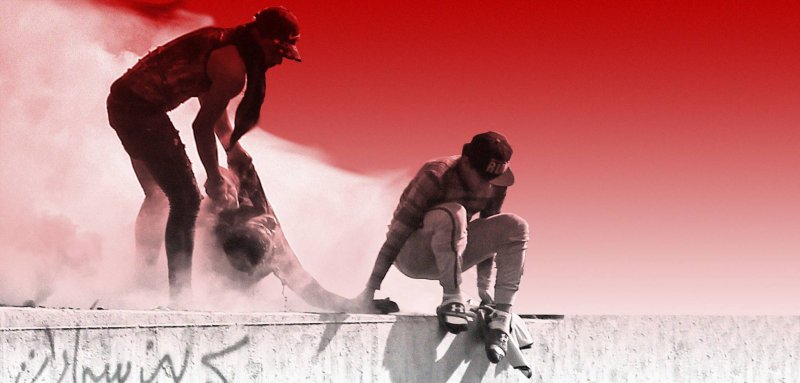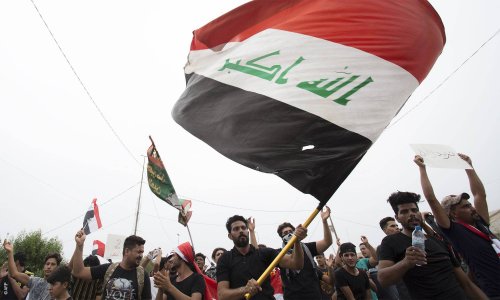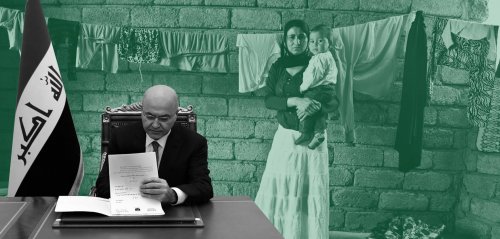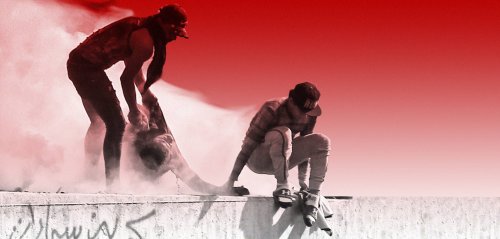“The Hajjam clan carry their hero martyr Abbas Dakhel Habib who was martyred during the peaceful demonstrations to his final resting place; he is the brother of Hassan, Hussein and Muhammad. The memorial service will be held at the Jafar Al-Tayyar Husseinieh in Al-Tajjar neighborhood as of 5/11/2019”.
This condolence announcement was written on a black banner, still hanging alongside the Iraqi flag on the wall of the Abbas family’s house in the city of Al-Shatrah in the Dhi Qar Governorate in southern Iraq. The family insists on keeping the notice on the wall until the demands for which Abbas was killed are fulfilled.
Abbas (17 years old) is one of the victims who fell in the demonstrations that broke out in October 2019 in the Iraqi capital Baghdad and the governorates of the south of the country, in protest against poverty (22.5%, according to what the Iraqi Ministry of Planning spokesman Abdul Zahra Al-Hindawi revealed to us) and unemployment (22.6% among the youth according to the same source) and corruption (Iraq was ranked 162th out of 180 countries on the corruption index in the world, according to Transparency International Organization 2019).
The bloodiest protests since 2003, which took place in nine governorates with a Shiite majority, killed 556 protesters and injured 22,799, according to the latest statistic published by the High Commission for Human Rights in Iraq (affiliated with the Iraqi parliament) on February 3. 2020. However, civil organizations and independent documentation centers confirm that the toll is greater than what is officially declared.
The independent Iraqi Center for Documentation of War Crimes is one of the institutions that question the statistic of the High Commission for Human Rights in Iraq, and according to the center that provided us with casualty figures which they documented, the toll was 752 killed, 24,488 wounded, and 2915 detained by the official security agencies and armed militias that have significant influence in the country. This statistic is for the period from the beginning of October 2019 until 6 February 2020.
According to The Iraqi Center for Documentation of War Crimes, 36 people (out of the total number of dead) were killed by tear gas canisters fired by Iraqi security forces on protesters throughout Iraqi cities that are witnessing popular protests.
Death of the Young Fishmonger
In a sad and angry tone, Hassan tells us the story of his brother Abbas, who was killed by a gas canister that lodged in his skull and crushed it: “He had just completed his seventeenth year. He decided to work selling fish in Shatrah Market to help us provide a living, but he dreamed of returning to school and one day getting a suitable job to build his future”.
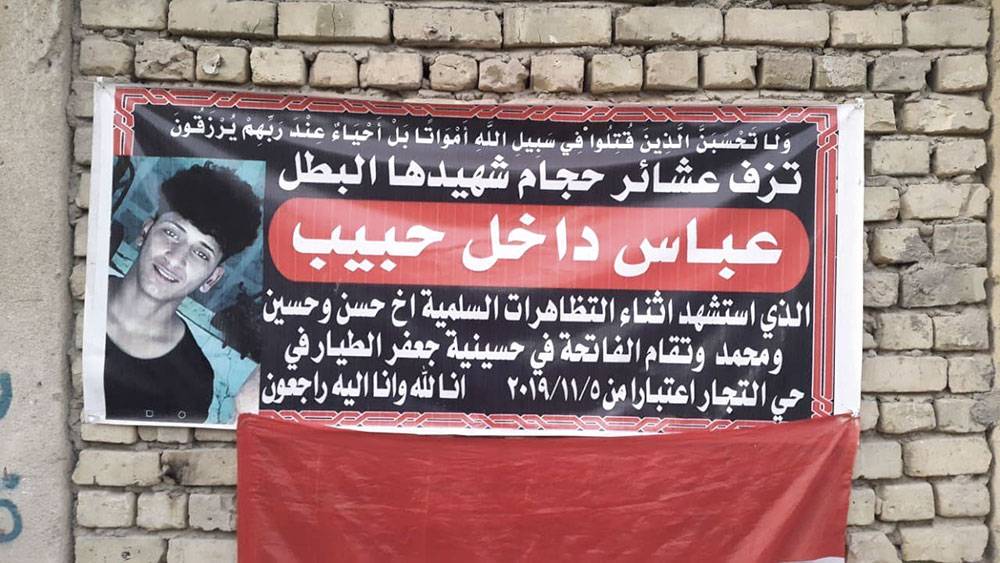
Banner announcing the death of Abbas Dakhel Habib during demonstrations in Dhi Qar Governorate
“When the protests started, Abbas left his fish stand, and participated with his buddies in demonstrations such as thousands of unemployed youth, those looking for a better future, believing that it was the only way to pressure the government to stop corruption”.
Hassan continues: “Abbas had nothing but the flag of Iraq, but they killed him. The corrupt government killed him, they killed him with tear gas canisters they buy with our money, it's a militia government that knows nothing but killing! In his short life he only saw poverty and unemployment. He went out demanding a decent living, but they brought him back to us a dead body with a shattered head”.
On November 4, 2019, after the escalation of demonstrations, the riot police withdrew from the city of Shatrah, where Abbas lives, to be replaced by Basra Emergency troops. When the protesters of Al-Shatra gathered in front of the house of the Secretary-General of the Council of Ministers Hamid al-Ghazi, the emergency force intervened to disperse them, firing live bullets and tear gas canisters, which resulted in 15 injuries, including three serious injuries that were transferred to Al-Hussein Teaching Hospital in the city, but two of the injured were dead. One of them was Abbas.
Abbas Dakhel Habib’s death certificate that we obtained from his family shows that the cause of death is: "Fractures, tears, and bleeding in the head due to an embedded projectile," without mentioning the nature of this projectile, while his family confirms that he was killed by being hit directly by a tear gas grenade or what is known to the local protesters as a "smoker".
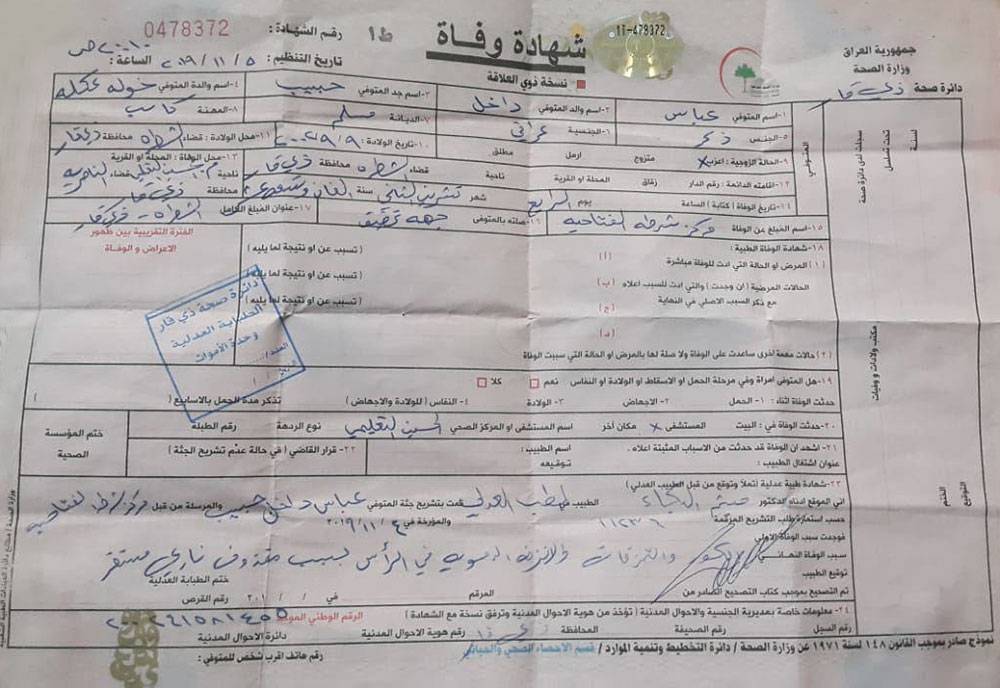
Abbas’s death certificate states that the cause of death is: Fractures, tears, and bleeding in the head due to an embedded projectile
In Dhi Qar governorate, which is witnessing bloody protests and a general strike in many government institutions and sectors, and according to a senior official in the Health Department who spoke on condition of anonymity- 104 protesters were killed, and 1467 were injured, including dozens of critical cases still lying in the governorate hospitals, while the number of detainees and abducted from the protesters reached 573. This statistic is for the period from October 1, 2019 to January 13, 2020.
As for the number of dead and injured due to their targeting with tear gas canisters, in Dhi Qar Governorate alone, 25 people were killed and 524 injured, according to the official who assured us that the majority of injuries are in the areas of the head and chest, and this is what makes these Canisters lethal, due to the firing by the security forces on to the bodies of the protesters directly.
According to the official, the Dhi Qar Health Department has not released any statistics on the number of victims since October 25, 2019, following directions from the provincial police chief, Muhammad al-Saidi, who ordered that the police headquarters be the only body authorized to announce the number of victims of the demonstrations.
We asked an official in the Dhi Qar Health Department about the reason security services are preventing the Health Department from announcing the death toll, he said: “The numbers are very large, and the police or security services in general fear the anger of the people when the real death toll is announced. There are dozens of injuries daily. The hospitals are overwhelmed with the dead and injured”.
Front Line Testimonies
During the demonstrations, the security forces used tear gas canisters on a large scale in Baghdad and cities in the south of the country. Dozens of videos, photos and testimonies, that we obtained, document the security forces firing these Canisters directly at the bodies of the protesters, causing hundreds of deaths and injuries.
From Al-Tahrir Square, which is the center of protests in Baghdad, as well as Al-Khilani Square, Al-Saadoun Street, and the Turkish Restaurant Building, and near the Republic Bridge, which is considered the front line between protesters and riot police, which in turn cut off the bridge to prevent protesters from crossing into the Green Zone where most of the state’s institutions, we obtained dozens of testimonies, photos, and videos from Al-Tahrir Square, which is the center of protests in Baghdad, as well as Al-Khilani Square, Al-Saadoun Street, and the Turkish Restaurant Building, and near the Republic Bridge, which is considered the front line between protesters and riot police, which in turn cut off the bridge to prevent protesters from crossing into the Green Zone where most of the state’s institutions, we obtained dozens of testimonies, photos, and videos from protesters and activists, as well as special testimonies of doctors of medical detachments that are stationed in the squares and streets that witness the momentum of the demonstrations.
They, in turn, provided us with CT scans of demonstrators who were killed or directly wounded in the head and chest areas with tear gas canisters.
An Iraqi protester gets a direct hit by a tear gas canister, Baghdad
Mustafa Ahmed (26 years old) is one of the demonstrators in Tahrir Square who suffered a direct foot injury with a tear gas canister, he says in his testimony: “I was exposed more than once to gas canisters, the chemicals in which make suffocate you, you cannot breathe, you cannot see around you as it is difficult for you to open your eyes, as if you were dying or passing out”.
Mustafa confirms that he was subjected three times to expired tear gas canisters: “The year of their expiry date referred to the year 2014 and this makes their toxicity more severe, so exposure to them is extremely dangerous ... If the injury occurred in the head or the body, survival will be difficult”.
“I witnessed myself a number of young men martyred with these canisters, especially on the bank of the Tigris River near the Al-Joumhouria Bridge”. Mustafa adds: “Some of them were killed by direct head injuries, while others suffocated. These types of canisters are designed to be used to disperse the protesters at worst, not to kill them”.
Riot police fire tear gas canisters directly at a demonstrator in Al-Joumhouria Bridge, Baghdad
We asked one of the doctors about her field observations, and she agreed to speak on the condition that we do not mention her name in the investigation, for fear for her career, as she is an employee in one of the capital's hospitals, but since October 25, 2019 she has been in Tahrir Square in shifts that sometimes extend for 14 hours with other doctors to provide treatment to the protesters.
The doctor says: “I was personally injured by a tear gas canister, which was thrown at the medical detachment, while we were helping the protesters, the symptoms were very painful, as the skin temperature raises dramatically, the muscles of the eyes cramp and lose the ability to open naturally. My colleagues forced me to open my eyes in order to give me eye drops called "Hyfresh", and for 15 minutes, I had severe pain in the eyes”.
Medical detachments in Tahrir Square and around are in constant danger, "the doctor asserts, adding:" At any moment, tear gas canisters or even live bullets can fall on us, the detachments are exposed in the streets, and spread to accommodate the large number of wounded, but there is no guarantee for the safety of doctors. We are here on the battlefield, this is how the security services deal with us”.
On November 7, 2019, while he was trying to help the wounded at the Al-Shuhada Bridge in Baghdad, the doctor, Abbas Ali, the head of the medical detachment in Al-Rusafi Street, was killed, and a doctor who was with him was wounded. We were able to obtain a video from one of the activists that documents the moment the doctor Abbas was killed and the protesters tried to rescue him.
The moment of the death of doctor Abbas Ali while trying to help the injured
Ali Shamil, another Doctor in the medical detachments of the Tahrir Square, warns of the dangers of some types of tear gas canisters used: “This type of gas is used in military battles, not in peaceful demonstrations”.
He says: “The canisters that are used contain toxic chemicals, and their inhalation in large quantities leads to spasms in the respiratory and muscular systems, which causes death”.
He added, “In the medical detachment where I work, I witnessed the death of three protesters after they inhaled large doses of gas under Al-Joumhouria Bridge, and on October 28, 2019 I had a shift at the Neurosurgery Teaching Hospital in Baghdad, and we received 15 cases of death with tear gas canisters, Some were due to direct targeting in the head and chest areas, and some were due to inhaling large doses of gas”.
Mustafa confirms that he was subjected three times to expired tear gas canisters: “The year of their expiry date referred to the year 2014 and this makes their toxicity more severe, so exposure to them is extremely dangerous
For Shamil, the danger also threatens the medical staff: “We were exposed to inhaling gas for long periods here in Tahrir Square, Al-Joumhouria Bridge, Al-Khilani Square and Al-Nasr Square. Smoke of the canisters is ceaseless, and we, the doctors, are exposed to injury and death at any moment, everyone here is in permanent danger”. Shamil believes that “major media blackout is taking place regarding the numbers of victims and wounded who fall by these canisters”.
The statements made by other witnesses from the protesters, doctors, and journalists we met in Baghdad and seven cities in southern Iraq: Babil, Karbala, Najaf, Nasiriyah, Shatrah, Samawah, and Basra, match the testimonials that we have documented in this investigation.

CT scan shows how tear gas grenades pierced Iraqi protester’ skull. We obtained the image from a doctor in the medical detachments of Tahrir Square
On October 31, 2019, Amnesty International issued a report entitled: "Iraq: Gruesome string of fatalities as new tear gas grenades pierce protesters’ skulls" in which it stated that the Serbian Sloboda Ĉaĉak M99 grenades and M651 tear gas grenades and M713 smoke grenades manufactured by the Defense Industries Organization (DIO) of Iran, had been used against the protesters in Iraq resulting in gruesome wounds and deaths.
Amnesty International urged Iraqi authorities to ensure that anti-riot police and other security forces in Baghdad immediately stop using two types of tear gas grenade that kill rather than disperse protesters, after their investigations concluded that those types caused at least five protester deaths in as many days.
Amnesty International carried out telephone and email interviews with numerous eyewitnesses, reviewed medical records and consulted medical professionals in Baghdad as well as an independent forensic pathologist about the horrific injuries caused by these grenades since 25 October 2019.
Since first publishing their findings on 31 October, Amnesty International noted that it had viewed and verified video evidence of further four additional deaths caused by the Serbian and Iranian grenades and has received a significant number of additional photos of the weapons, via sources on the ground. It noted, however, that it has no information on the identities of the security forces firing these Iranian M651 and M713 grenades in Baghdad.
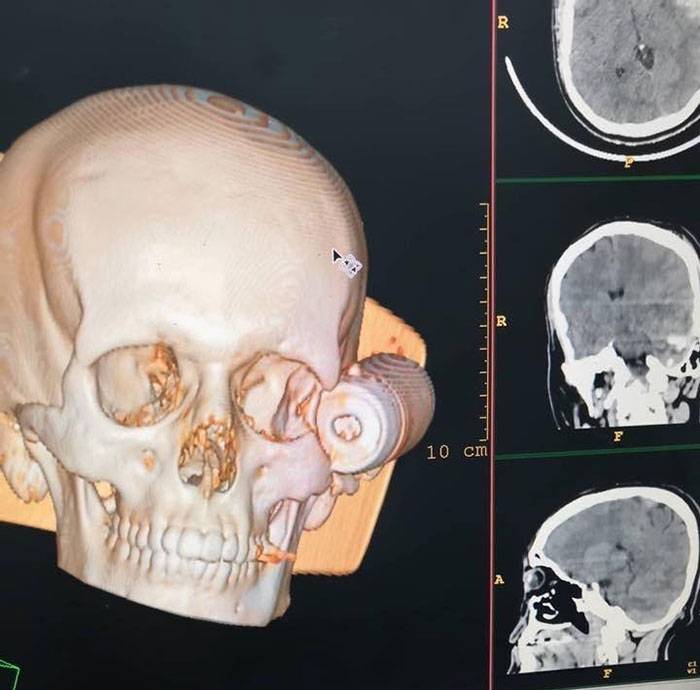
CT scan shows tear gas canister fatally embedded into an Iraqi protester’s brain. We obtained the image from the Neurosurgery Teaching Hospital in Baghdad
“All the evidence points to Iraqi security forces deploying these military-grade grenades against protesters in Baghdad, apparently aiming for their heads or bodies at point-blank range. This has had devastating results, in multiple cases piercing the victims’ skulls, resulting in gruesome wounds and death after the grenades embed inside their heads,” said Lynn Maalouf, Middle East Research Director at Amnesty International.
There are at least two models of canisters that are responsible for killing and injuring protesters in Iraq, according to the report, and these models are: Serbian 40mm M99s, manufactured by Sloboda Čačak and distributed by Balkan Novotech and Yugoimport; and 40mm LV grenades, including M651 tear gas grenades and M713 smoke grenades manufactured by the Defense Industries Organization (DIO) of Iran.
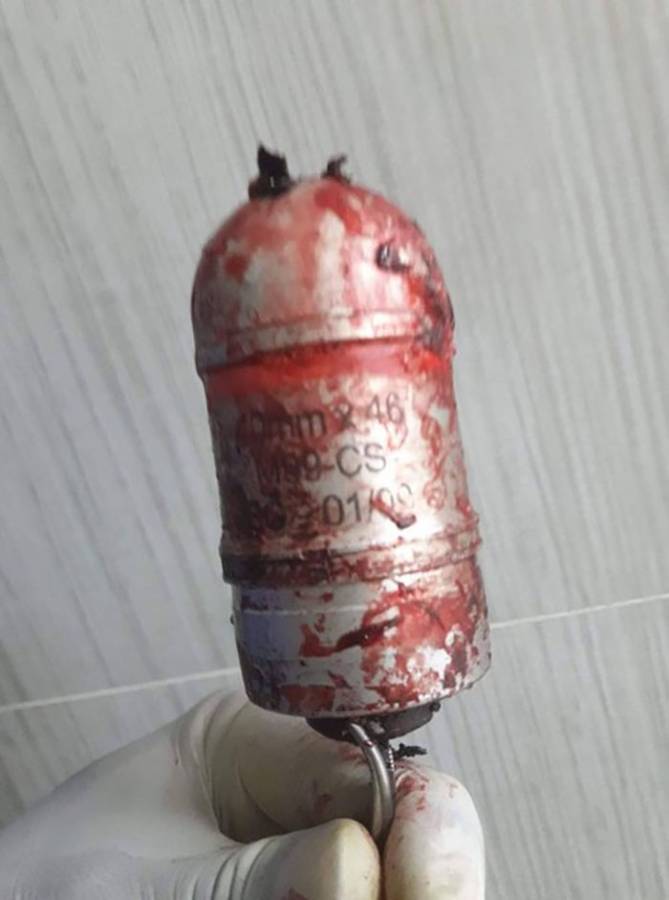
A tear gas canister extracted from the head of a protester in Baghdad. We obtained this photo from the medical detachment in Tahrir Square
To talk about the excessive and deadly use of these canisters by the Iraqi security forces, we met in Istanbul the military expert and Brigadier General Subhi Nazim Tawfiq, he assured us after showing him the photos and videos that we have that what the Iraqi security services are doing is premeditated murder : "During my follow-up to the worldwide phenomenon of protesting around the world over several decades, I haven’t seen such a suppression similar to what played by Iraqi security forces in dealing with the protesters, because these forces use rules of engagement used in battles with unarmed civilians”.
Tawfiq adds: “In all countries, security forces receive special training to deal with public protests. Forces that deal with and interact with protesters must be highly aware and focused to ensure that there are no casualties. There are rules of engagement in critical and rare situations that protests may reach, in which force can be used on top orders, these critical cases hasn’t occured in the demonstrations of Iraq”.
Tawfiq accused the Iraqi authorities of violating the basic principles issued by the United Nations, which relate to the use of force and firearms by law enforcement security forces: "The basic principles of the United Nations state that the use of force and firearms by law enforcement officials should be commensurate with due respect for human rights. Law enforcement officials, in carrying out their duty, shall, as far as possible, apply non-violent means before resorting to the use of force and firearms. They may use force and firearms only if other means remain ineffective or without any promise of achieving the intended result, and that's what the Iraqi security forces haven’t done”.
Lethal Canisters
In the Iraqi capital, the largest number of casualties occurred using tear gas canisters, particularly in Tahrir Square, the Al-Joumhouria Bridge and al-Khalani Square, where security forces used excessive force to suppress protests. Although the investigative committee tasked with Iraqi Prime Minister Adel Abdul-Mahdi (His resignation was submitted on 30 November 2019) claimed that a third party other than the security forces killed the protesters during the first week of October 2019, but the results of its investigation did not address the excessive use of tear gas canisters against protesters.
Iraqi protester getting hit by a tear gas canister, Al-Khilani Square, Baghdad
The investigation committee revealed the final outcome of the victims of the first wave of demonstrations, which lasted from October 1, 2019 to October 7, 2019, during which the death toll reached 157 people, with 5494 more injured in the governorates: Baghdad, Najaf, Babil, Diwaniyah, Missan, Dhi Qar, Wasit, Al Muthanna and Basra.
Two weeks later, on October 25, 2019, the second wave of popular demonstrations began. Despite the promises of then-Prime Minister Adel Abdul-Mahdi to protect the protesters and his pledges that the violence that occurred the first time will not be repeated; however, the death toll has increased significantly since that period. The death toll of the second wave of the Iraqi protests reached 399 killed and 17,305 wounded, according to the statistics of the High Commission for Human Rights in Iraq, which was published on February 3, 2020, as we mentioned the beginning of the investigation.
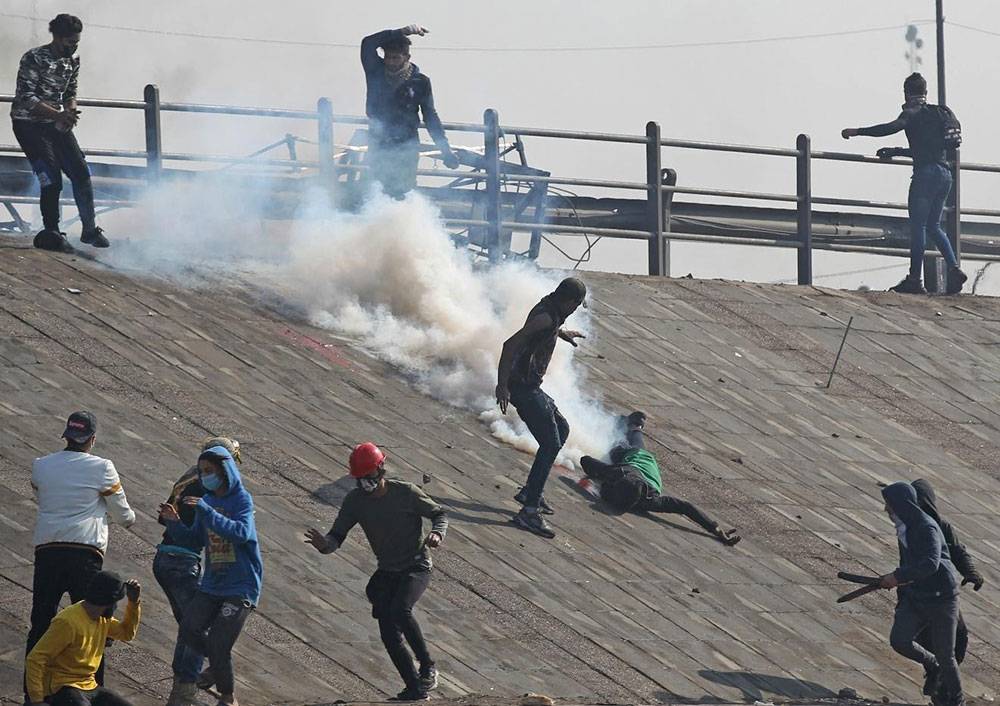
An Iraqi protester fell after getting hit by a tear gas canister on Mohammad al-Qasim road, Baghdad's. (Photo by Ahmad Al-Rubaye/AFP)
In order to find out the actual number of victims of the demonstrations, as well as the number of victims of tear gas canisters, we contacted the official spokesman of the Ministry of Health and Environment Dr. Saif Al-Badr, and we asked him questions about the total number of deaths of the demonstrations since its inception, as well as the number of injured, and how much is the percentage of victims of tear gas canisters from the total number of the victims. Al-Badr declined to comment on the matter, citing "high up orders" according to which the Ministry of Health and Environment refrain from giving any numbers of the victims, and that the only authorized person to announce the casualty toll is the spokesperson for the Commander-in-Chief of the Armed Forces, Major General Abdul Karim Khalaf.
We called Major General Khalaf and asked him specific questions: Are there orders for the security services to launch tear gas canisters in a horizontal manner and straight to the bodies of the protesters? In the event that no such orders are given, what's your comment on the direct targeting of protesters with these canisters by the security services in Baghdad and the rest of the cities that are witnessing protests? And were you able to reveal the identity of the "third party" that the commission of inquiry assigned by the Prime Minister said was the one who fired at protesters? After finishing asking questions, Khalaf stayed silent for a while. After asking him again, he apologized for not answering claiming that he has to join an "important security meeting”, without confirming or denying any of the questions posed.
One day after contacting Major General Khalaf, on November 12, 2019, to be precise, he appeared at a press conference to talk about the demonstrations and developments. Responding to a question about the tear gas canisters, he said: “We use only SC gas that is used by the United States, Britain, France, Russia, and all the other countries of the world. It is a combination of gases containing black pepper and another chemical substance, which only causes teary eyes. The amount of gas released from the canister harms the protester for a temporary period, and as soon as the protester is removed from the place he returns to his normal state”.
Khalaf’s words were refuted by an interesting statement by the Iraqi Minister of Defense Najah al-Shammari on November 15, 2019, in which he revealed that the Iraqi security forces used weapons to launch tear gas canisters with a range of 75 to 100 meters, with the same ammunition used in all countries of the world. But he added, however, that killings of protesters have been more than 300 meters away from the security forces.
Moreover, Al-Shammari also said: “After going to forensic medicine and removing the projectile from the heads of the demonstrators, we found that this equipment was not imported by any Iraqi party, and that the launcher, the rifle and the ammunition entered Iraq not through the Iraqi government. It was also poorly used, and the weight of the projectile was three times the weight of the projectile used by the competent security forces,” confirming the presence of a “third party that kills demonstrators and security forces” alike.
In order to obtain clarifications and details about the identity of the third party that is killing the demonstrators and the security forces, we’ve attempted to communicate with: the spokesman for the Ministry of Defense, Major General Tahsin al-Khafaji, and the Interior Ministry spokesman, Brigadier Khaled al-Muhanna, as well as the spokesman for the Commander-in-Chief of the Armed Forces, Major General Abdel Karim Khalaf, each Separately, they all declined to comment, refraining from returning our calls.
Killing of an Iraqi protester with a tear gas canister, Baghdad
Ghaith Ahmed, one of the protesters who stand in what's known as the "Front line" on the Al-Joumhouria Bridge, a barricade that separates the protesters from the security forces. Ghaith denies the words of the spokesman for the commander-in-chief of the armed forces, stating that “tear gas canisters are much more deadly and dangerous”, he adds, “We have lived through the demonstrations from the beginning, at which they repressed us with live bullets and snipers in the first week of October 2019, but we came back again on October 25, 2019, that's when they used the deadly gas canisters against the demonstrators”.
Ghaith describes how tear gas canisters were fired by riot police: “They were spraying the square every time with canisters, you feel it like it's raining gas. On 25 and 26 October, 2019 the canisters that were fired at us at Al-Joumhouria Bridge and Tahrir Square were expired, its expiration date is in 2014”.
Ghaith believes that the "Front line" on the Al-Joumhouria Bridge was the most dangerous place for the protesters: “On the first of November, three martyrs fell on the front line, when one of the doctors came to help the wounded, she also got hit by a tear gas canister in her stomach, they transferred her by tuk-tuk”.
Ghaith told us what makes the "Front line" the most dangerous is the close range from which riot police fire tear gas canisters:
“They fired those canisters directly at us, and in recent days, they started using different types of canisters that, when it explodes, would spread shrapnel in the target area. As a result, there have been cases of amputation of the hand and foot, and injuries to the head and body”.
We were able to get a video from Ghaith that he had filmed on October 26, 2019, in which he documents riot police firing tear gas canisters directly at the protesters at Al-Joumhouria Bridge.
Iraqi security forces firing tear gas canisters at demonstrators
Human Rights Watch issued a report, on November 8, 2019, in which it accused the Iraqi security forces of firing tear gas cartridges directly at the demonstrators in Baghdad: “Security forces have fired teargas cartridges directly at protesters in Baghdad, Iraq on numerous occasions since protests resumed on October 25, 2019, killing at least 16, Human Rights Watch said today. The dead are among the large number of protesters Iraqi forces have killed since daily protests began in Baghdad and in other cities in southern Iraq against corruption and for better public services, among other demands”.
Killing of a protester in Baghdad with a tear gas canister
The organization analyzed video footage filmed by Reuters on October 27 and 29, which it corroborated with witness interviews. The footage shows security forces on -Bridge firing into the crowds at the foot of the bridge, which opens onto Tahrir Square. The October 27 clip shows "one officer to the right firing teargas cartridges in an upward trajectory while on the left another officer is firing in a flat trajectory at crowds of protesters less than 100 meters away".
"Since the protests began, senior government officials have forbidden medical staff from sharing information on the dead and injured with any sources outside the Health Ministry, and the ministry has been releasing minimal and incomplete information"
The contrast in firing techniques raises the question of whether some forces are operating side-by-side under different orders, whether they all have orders to disperse the crowds in any way they see fit, or whether forces are disregarding their orders, Human Rights Watch said.
Circling Around the Freedom Monument
On October 28, 2019 fell one of the most important activists in the demonstrations in the Iraqi capital, Baghdad, Safaa al-Saray, a poet, painter, and computer programmer who born in 1993 in Baghdad.
Safaa was hit with a tear gas canister in his head on Monday afternoon, and died after midnight in Neurosurgery Teaching Hospital in Baghdad. His funeral was held at dawn on Tuesday in Tahrir Square. In compliance with his will, the mourners carried his body around the Freedom Monument in a funeral that broke the curfew imposed by the Iraqi authorities at the time.
The funeral of Safaa al-Saray in Tahrir Square, Baghdad
In Baghdad, we met Ali Thabit, a friend who was close to Safaa and his companion in the demonstrations since their very inception, and the last one who had a sandwich of falafel in Al Umma Park in central Baghdad. He told us the story of Safaa since he started demonstrating in the beginning of October 2019 till his death at the end of that month.
“At the beginning of October 2019, I left work on Rashid Street heading to Tahrir Square, and from there to Tayeran Square, where came a crowd of people led by Safaa Al-Saray chanting: "long live iraq" and other national chants for peace and freedom. When Safa approached me, we hugged then led together the demonstration in Tayeran Square,” Ali told us, while lighting his cigarette at the top of the Turkish restaurant building, which is controlled by the demonstrators.
Ali continues: “It took only 15 minutes until the security forces started firing tear gas and sound canisters towards the demonstration, so people began to disperse but Saffa and I remained to document what was going on by filming with our mobile phones, Safaa tried to remove one of the tear gas canisters with his hand but it burned him. It made us suffocate, then the security forces started firing live bullets at us, so we withdrew to the Karrada area”.
“In the first week of the demonstrations, we were documenting all the violations that occurred, then we were sending them to NRT TV for broadcast as the government was cutting the Internet at the time. We were exposed to death every day by snipers deployed on the roofs of tall buildings. later, armed militias stormed the offices of NRT TV In Baghdad, they destroyed the devices and made the TV station stop broadcasting. So, our friends who were documenting the demonstrations with us traveled to northern Iraq (Kurdistan) for fear of these militias, since the computers at the station contained files with our names in it, but Safaa and I stayed in Baghdad to participate and document the demonstrations”.
Safaa al-Saray filming the demonstrations near Tahrir Square
Ali continues: “On October 24, 2019, Safaa called to ask me to stay overnight at his house so we can go out early to Tahrir Square. At that night, Safaa couldn't sleep with all the excitement and anticipation he had, all his talk was about Iraq and how to change its grim reality. In the morning we went to Tahrir Square and then to Al-Joumhouria bridge. We were documenting everything that happens because we know that the authority will cut off the Internet; therefore, there was no way except to document the repression with our phones then look for television channels that broadcast these videos to show the world the ugliness of what we were going through”.
He adds: “One day, Safaa was injured by shrapnel of a tear gas canister, and his phone was lost in the midst of the protesters. Five minutes later, I was also injured in my right hand. We got separated amid the crowds, then after two hours we met again, we decided to take selfie to immortalize the moment”.
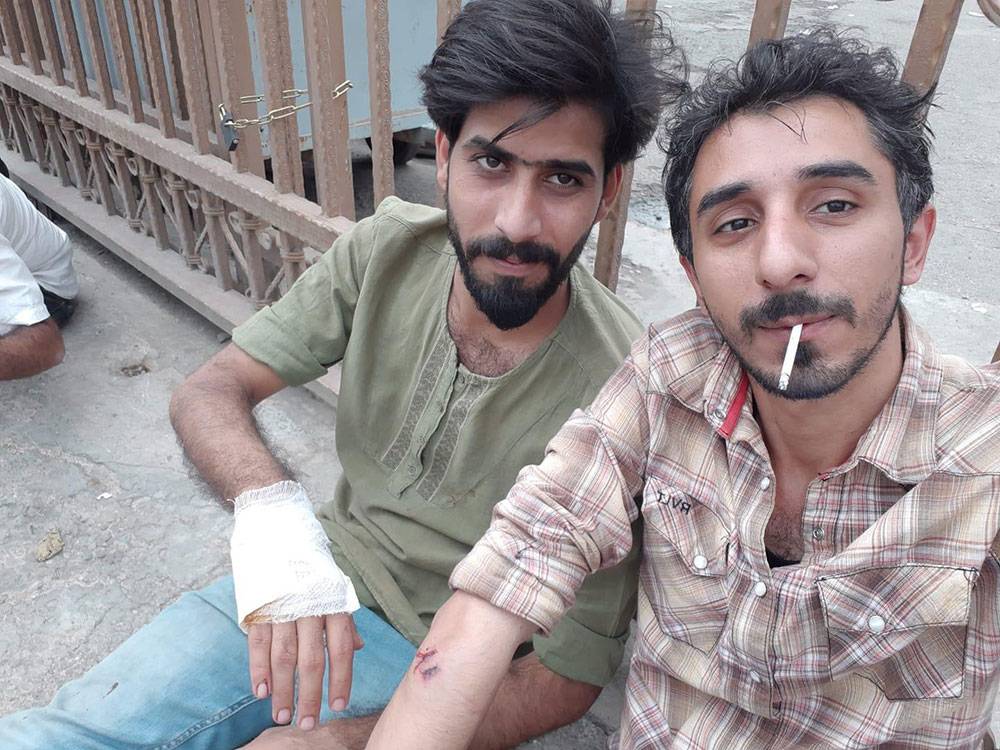
From left: Safaa Al-Saray and Ali Thabit, showing the effects of the injury on their hands
We asked Ali about the last moments in the life of his friend Safaa, he replied: “On October 28, 2019, we were demonstrating in Tahrir Square, then we sat in Al Umma Park where we ate. After getting refreshed, we went to the front lines on Al-Joumhouria Bridge, there, tear gas canisters were passing near our heads, at a distance of half a meter or less, we were cheating death at that point, then we parted among the crowds. Later, we met again in Al Umma Park, we sat talking and laughing, then I fell asleep there from exhaustion. Safaa returned to the demonstration where he was hit by a tear gas canister in the head, we could not save him. Safaa died that night, and his funeral was in Tahrir Square as he wanted, we buried him near his mother, Thanwah, whom he liked to be called with her name: "Thanwah‘s son".
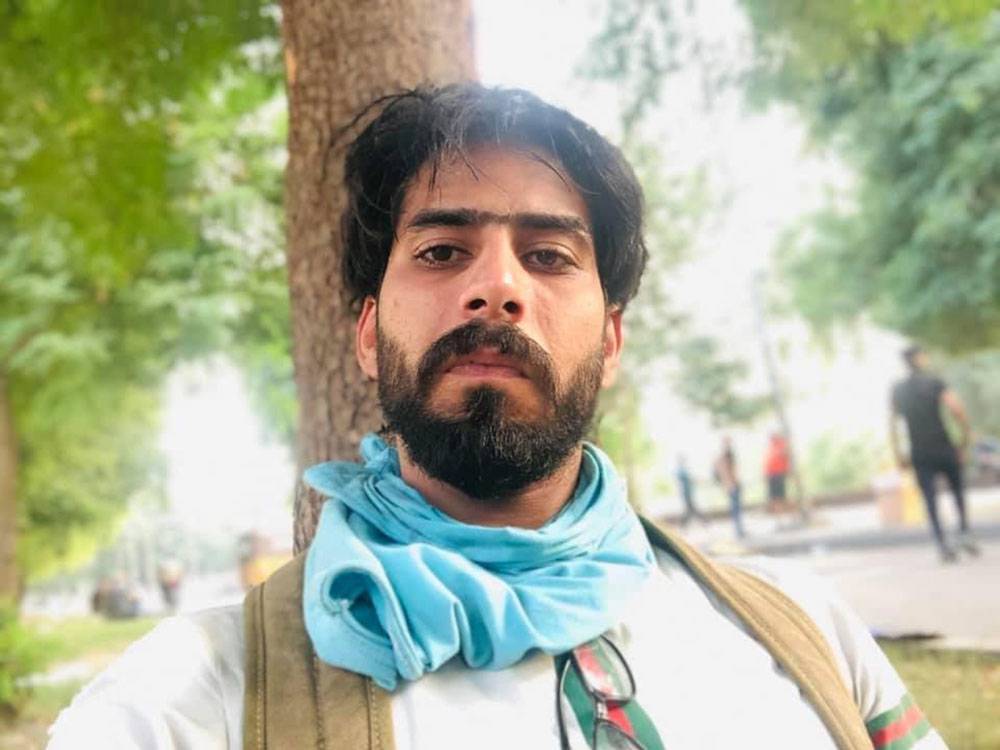
Last photo taken by Safaa in Al Umma Park a few hours before his death
Near Tahrir Square, a tent set up by Safaa Al-Saray's friends, they called it "The Tent of Thawna’s Children”. This tent provides food and drink for the protesters, and in which the friends of Safaa sit at night, and go to participate in the demonstrations during the day, while they are wearing T-shirts printed with the last picture taken by Safaa in Al Umma Park before his death.
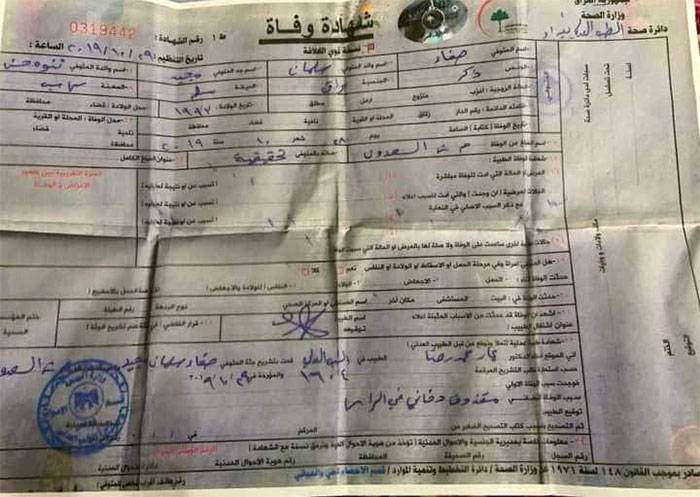
.The death certificate of Safaa al-Saray, written in the place of the cause of death: Smoke projectile in the head
"The Tent of Thawna’s Children” is one of dozens of tents that protesters have set up in Tahrir Square and the streets leading to it, since the twenty-fifth of October 2019. The setting up of these tents by the protesters coincided with their announcement of sit-ins in Baghdad and other cities witnessing protests until the government responded to their demands.
Raseef22 is a not for profit entity. Our focus is on quality journalism. Every contribution to the NasRaseef membership goes directly towards journalism production. We stand independent, not accepting corporate sponsorships, sponsored content or political funding.
Support our mission to keep Raseef22 available to all readers by clicking here!
Interested in writing with us? Check our pitch process here!
